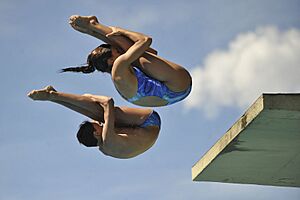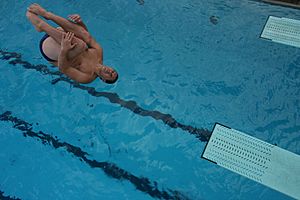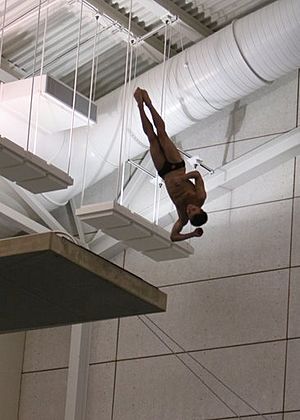Diving facts for kids
Diving is when someone moves downwards, usually from the air into water. It's also an exciting sport! Divers often jump from a springboard or a high platform.
There's also Underwater diving, like Scuba diving. But scuba diving isn't usually seen as a sport. The dives for scuba diving are pretty simple, like a "giant stride entry" where you just step into the water.
Diving as a Sport

Most diving competitions have three main parts: dives from a 1-meter springboard, a 3-meter springboard, and a high platform. Athletes compete in groups based on their gender and age. For platform diving, competitors can choose to dive from 5, 7.5 (often called just 7), or 10-meter towers. In big events like the Olympic Games, platform diving is always from the 10-meter height.
Divers must perform a certain number of dives. These dives include cool moves like somersaults and twists. Judges score divers on how well they do each part of the dive. They also look at how straight their body is and how little splash they make when they enter the water. A perfect score is 10 points. Three points are for the takeoff, three for the flight, and three for the entry. There's one extra point for the judges to use for overall impression.
The diver's score is then multiplied by a "difficulty factor." This factor depends on how many somersaults and twists they try. The diver with the highest total score after all the dives wins!
What is Synchronized Diving?
Synchronized diving became an Olympic sport in 2000. In this event, two divers work as a team. They perform their dives at the exact same time. Usually, their dives are identical. But sometimes, they do "pinwheel" dives, where one diver does a forward dive and the other does an inward dive. Judges score these dives on how well each diver performs. They also score how perfectly timed and similar their take-offs, heights, and entries are.
How Do Judges Score a Dive?
Judges follow specific rules to score a dive. They look at three main parts: the approach, the flight, and the entry into the water. Here are some things judges consider:
- If the dive starts with a handstand, how long and steady the handstand is.
- How high the diver goes in the air. Higher is usually better!
- How far the diver stays from the diving board. They shouldn't be too close or too far.
- The diver's body position. Their toes should be pointed, and their feet should be together.
- Making the right number of spins and twists.
- How straight the diver enters the water. Less splash usually means a higher score.
In synchronized diving, there are more judges. Some judges score each diver's performance. Other judges focus only on how well the two divers are synchronized.
Winning a Diving Competition
To win a diving competition, divers plan their "dive list" beforehand. They want to get more points than anyone else. Simple dives might look good, but they often don't win competitions. Top divers try to do the hardest dives they can perform well. If a diver consistently scores 8s or 9s on easy dives, they might lose to someone doing harder dives with slightly lower scores.
Divers must submit their dive list before the competition starts. They can't change their dives after a certain time. If a diver doesn't do the dive they announced, they will get a score of zero. Sometimes, in rare cases, a diver might get a chance to redo a dive. This usually happens only for very young divers or if something unexpected happens.
Different Types of Dives
There are six main types of dives and four different body positions a diver can use.
What Are the Main Types of Dives?
The six types of dives depend on which way the diver faces and how they spin.
- Forward: The diver faces the water and spins forward.
- Backward: The diver stands with their back to the water and spins backward, away from the board.
- Reverse: The diver faces the water but spins backward, towards the board.
- Inward: The diver faces away from the water and spins forward, towards the board.
- Twisting: This is any of the above dives where the diver also twists their body left or right.
- Armstand: The diver starts this dive in a handstand position, not standing on their feet.
What Body Positions Do Divers Use?
Divers use four main body positions during their dives:
- Tuck: The diver bends their body at the waist and knees. Their thighs are close to their chest, and their heels are close to their bottom.
- Pike: The diver's legs are straight, but their body is bent at the waist. Their arms can be in any position, often pointed towards their toes.
- Straight: The diver's body is completely straight, with no bends. There might be a slight arch in the back for some dives.
- Free: This isn't a single position. It means the diver uses more than one position during the dive. It's common for dives with somersaults or twists.
Understanding Dive Numbers
Dives are given numbers based on their direction and position.
- 100s = Forward dives
- 200s = Backward dives
- 300s = Reverse dives
- 400s = Inward dives
- A = Straight position
- B = Pike position
- C = Tuck position
- D = Free position
For example, a "Front dive Tuck" is a 101C. The last number goes up by one for every half flip.
Why is Height Important in Diving?
Going as high as possible during a dive is good for several reasons:
- Judges give higher scores for greater height.
- More height means more time in the air. This gives the diver more time to do their spins and twists.
- A higher dive helps the diver enter the water further away from the board. This is important for safety.
How Divers Control Their Spins
Divers can control how fast they spin by changing their body shape. When a diver pulls their body into a tight tuck, they spin faster. When they stretch out into a straight position, they spin slower. This is because of something called "angular momentum." It's like a figure skater spinning faster when they pull their arms in.
The tuck position gives divers the most control over their spin speed, making these dives easier. Straight dives are the hardest because there's almost no way to change the spin speed once they leave the board.
When divers enter the water, they don't completely stop spinning. Expert divers make it look like they enter perfectly straight. They might start their entry slightly angled so that their legs are vertical as they disappear under the water. They can also use "entry save" moves by moving their upper body and arms underwater to help straighten their legs.
The Art of Twisting Dives
Dives with many twists and somersaults are amazing to watch and very difficult to do! Divers aren't allowed to start twisting right when they leave the board. Instead, they use some of their somersaulting spin to create the twisting motion.
They do this by tilting their body sideways after takeoff. They use their arms, which are usually stretched out to the sides. When one arm moves up and the other moves down (like turning a big steering wheel), their body tilts. This tilt starts the twisting spin. To stop twisting, they reverse the arm motion, which straightens their body and stops the twist.
Entering the Water
The rules say that a diver should enter the water vertically, or almost vertically. It's impossible to be perfectly vertical because divers are still spinning a little. So, divers try to create the illusion of a straight entry. One trick is to let the upper body enter slightly angled. This way, as the body continues to spin, the legs enter perfectly straight. Another trick is to use "entry save" moves. This means scooping the upper body underwater in the direction of the spin to help pull the legs into a vertical position.
For dives where the feet enter first, the arms must be by the diver's side. These dives are usually only done on the 1-meter springboard and in lower-level competitions. For "head-first" dives, which are much more common, the arms are extended forward and in line with the body.
Years ago, divers used to interlock their fingers. Now, the common way is for one hand to grasp the other with palms down. This creates a small vacuum between the hands, arms, and head. If the entry is vertical, this vacuum helps pull any splash down and under the water. This creates the famous "rip entry," which makes very little splash.
Once a diver is completely underwater, they can roll or scoop in the direction of their dive's spin. This helps pull their legs into an even more vertical position.
Related pages
Images for kids
-
Swedish high diver Arvid Spångberg at the 1908 Summer Olympics
-
A sign prohibiting diving at a beach in Kirkland, Washington
-
Tomb of the Diver, Paestum, Italy, an ancient Greek painting from 470 BC
-
The University of Houston's CRWC Natatorium, home to a very large college swimming pool.
-
A man and woman jumping off a cliff at Colliding Rivers, Glide, Oregon.
-
A man diving into Lake Michigan.












